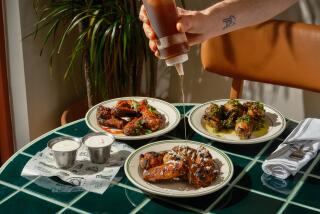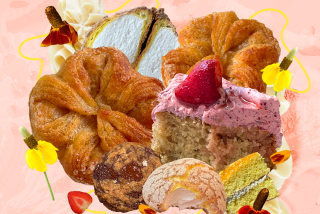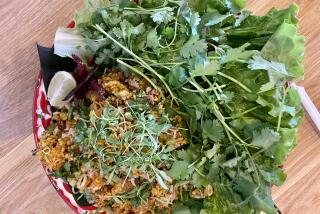Dosa: A Most Flexible Pancake
- Share via
The dosa is a hugely versatile food. In India, it can be a light snack or a meal in itself. It can be made light and lacy or thick and substantial. It can take a simple five minutes to prepare or a marathon 24 hours. Its batter can be refrigerated for a week and still not lose its taste. And it can be made in a hundred different ways, to suit a hundred different tastes.
All of this I know from personal experience. When I was growing up in India, we used to have the most marvelous summer vacations at my grandparents’ rambling house. It seemed to me that at any given time there were a hundred people there--uncles, aunts, cousins, second cousins, widowed great aunts, neighbors and a stray friend or two.
One of the simplest ways of feeding the tribe was to prepare gallons of dosa batter, with gallons of sambar and coconut chutney to go with it. The dosa batter and chutney would be ground in an oversized version of a stone mortar and pestle. Even simpler was making a dosa that could be eaten with just homemade hot mango or bamboo shoot pickles, or with date syrup or honey.
The women of the house would take turns standing over the hot griddles to keep the dosas coming. The children, once they were done eating, were recruited to yo-yo between the dining table and the kitchen with the fresh batches. That we needed urgent refueling for this arduous task was taken as a given, and a handful of banana chips or a cream of wheat ladoo did absolute wonders to keep up our strength.
The secret of the perfect dosa lies primarily in the making of the batter. The sourdough dosa, which forms the basis for the masala dosa and is probably the most labor-intensive of dosas, is made with rice and the legume urad dal (a kind of black lentil). It has to be blended to the perfect consistency and fermented correctly in order to get it right. The warm weather in south India speeds up the fermentation process, but in more temperate climes, it can take up to 12 hours.
It’s a good idea to prepare a small amount of batter to begin with. Make half a batch to start. But even with a perfect batter, the crispy mile-long masala dosa served in restaurants does take a bit of practice--and griddle space--to achieve.
But don’t worry. You don’t need to make it a mile long. It need not be a perfect circle, and it’s allowed to be more than a millimeter thick--even if you’re not cooking for hundreds of hungry relatives.
*
Sada Dosa
Active Work and Total Preparation Time: 30 minutes, plus 12 hours standing * Vegetarian
1/2 cup split urad dal
1 1/2 cups long-grain rice
1 teaspoon salt
Oil
Wash the dal and rice separately until the cloudiness in the water disappears. Soak them separately in tepid water to cover at room temperature until the dal expands and softens and the rice takes on a white opaqueness, about 4 hours. Drain and reserve the liquid.
Grind each separately in a blender, using enough of the reserved liquid to make a smooth consistency. The batter for both should be very thick, so add as little water as possible. To check the consistency, take a small amount of batter and rub it between your index finger and thumb. You should feel no grittiness.
Empty both batters into an oversized bowl (the batter will double when fermented), using more of the reserved water to wash out the stubborn bits stuck in the blender. The batter should now be of the consistency of pancake batter that is neither runny nor lumpy when dropped. Add the salt and mix thoroughly.
Cover the bowl loosely with plastic wrap and place it in a warm oven (For a gas oven, heat from the pilot light should be enough; for an electric oven, heat at 225 degrees 5 minutes then turn it off. A temperature of 85 to 90 degrees is essential to the fermentation process.). Leave it to ferment overnight (at least 8 hours). South India feels like an oven most months of the year, so one isn’t really needed there for this purpose.
The next day, remove the bowl from the oven and mix thoroughly again. It should have doubled in volume and become thick and foamy. It should also smell slightly sour. The batter is now ready for frying; it can be covered and refrigerated at this stage if the dosas are not going to be prepared at once.
Heat a nonstick griddle or frying pan over medium-high heat. Lightly oil the surface, seasoning the pan. Blot off any excess oil with a bunched-up paper towel.
Ladle 1/4 cup of batter into the center of the hot pan or griddle and immediately, beginning at the center, spread the batter out in a circular motion, using the bottom of the ladle, until the batter is spread out thinly. Spoon a little oil around the edges and cook, covered.
Uncover after about 30 seconds. Small holes should have formed on the surface of the dosa and its edges should have separated from the pan. Leave for 30 more seconds before lifting one side gently and folding it over the other. It should be crisp at this point. To get it crackly-crisp, add more oil around the edges after spreading the batter.
Best served immediately with Coconut Chutney and sambar.
About 14 dosas. Each dosa: 29 calories; 169 mg sodium; 0 cholesterol; 0 fat; 0 saturated fat; 5 grams carbohydrates; 1 gram protein; 0.74 gram fiber.
*
Masala Dosa (Stuffed Dosa)
Active Work and Total Preparation Time: 50 minutes plus 12 hours standing * Vegetarian
This, basically, is the Sada Dosa with a potato mixture (bhaji) spooned into it. The masala is the icing on the cake, as it were, and lifts the ordinary crepe into something quite special. Having said this I must admit that I have a preference for the humble sada dosa because it is pure, simple and wholesome. Of course, the fact that I once massively binged on masala dosas and suffered its consequences might be a large part of the reason too.
4 white boiling potatoes, peeled
Salt
1 tablespoon oil
1 teaspoon brown mustard seeds
1 tablespoon chana dal
5 curry leaves
2 onions, chopped
1/2 teaspoon ground turmeric
1 teaspoon salt
Sada Dosa
Boil the potatoes in salted water until tender, about 20 minutes. Drain them, reserving the water. Coarsely mash the potatoes.
Heat the oil in a nonstick saucepan over medium-high heat. Keep all the ingredients close at hand. When the oil reaches the smoking point, add the mustard seeds. These will immediately start to splutter and pop. Keep a splatter screen handy to fend off any hot oil burns. When the spluttering eases off, about 5 to 8 seconds, reduce the heat and add the dal and the curry leaves. Fry a few more seconds until the dal turns brown.
Add the onions and fry until golden brown, 12 to 15 minutes. Then add the potatoes, turmeric and salt. Mix well. Add 3 to 4 tablespoons of the reserved potato water, mix again and cook until the water is absorbed and the bhaji is fairly dry in texture, 2 to 3 minutes.
Cook the Sada Dosa (following the Sada Dosa recipe directions), and as each dosa is finished, spoon about 2 tablespoons of the bhaji onto one half of the dosa, then fold the other half over it. Restaurants often place the bhaji in the center of the dosa and fold the two sides over it to make it rectangular rather than half moon shape. Repeat until all the filling is used.
Eat promptly with Coconut Chutney and sambar.
About 14 dosas. Each dosa: 60 calories; 192 mg sodium; 0 cholesterol; 1 gram fat; 0 saturated fat; 10 grams carbohydrates; 2 grams protein; 1.44 grams fiber.
*
Coconut Chutney
Active Work and Total Preparation Time: 20 minutes * Vegetarian
3/4 cup water
1/2 teaspoon tamarind paste
1 1/2 cups grated unsweetened coconut
1 serrano chile, seeded and minced
1 tablespoon finely shredded ginger root
1 1/2 tablespoons chana dal
1 teaspoon salt, more to taste
1 tablespoon oil
1 teaspoon mustard seeds
10 to 15 curry leaves
Place the water and tamarind paste in a small saucepan and simmer until the paste is softened.
Place the coconut, chile, ginger, chana dal, tamarind paste mixture and salt in a blender container and puree until smooth, about 5 minutes. Transfer to a bowl and set aside.
Heat the oil in a small skillet over medium-high heat to the smoking point and add the mustard seeds. Cover to avoid any oil splatters. After the mustard seeds pop, toss in the curry leaves and cover again, 30 seconds. Remove from the heat and add to the bowl. Mix thoroughly.
The chutney tastes best when eaten on the same day. It can be refrigerated but not frozen, and has to be brought back to room temperature and mixed with some warm water before being served. Do not microwave.
1 1/2 cups. Each tablespoon: 58 calories; 102 mg sodium; 0 cholesterol; 6 grams fat; 4 grams saturated fat; 2 grams carbohydrates; 1 gram protein; 0.35 gram fiber.
*
Shallot Sambar
Active Work Time: 30 minutes * Total Preparation Time: 1 hour * Vegetarian
This is a spicy, wholesome stew made with dal and vegetables. In this version, I use shallots, which lend a slightly sweet taste to the sambar. You could also use vegetables such as potatoes, onions, green beans, eggplants, radish, carrots and tomatoes. The sambar is a mainstay of the South Indian daily diet and is eaten with rice, dosas or idlis (dumplings). You will need to make a special mix of spices--sambar powder--for this. The powder is also commercially produced and available in Indian grocery stores.
1/2 cup toor dal
2 1/4 cups water, divided
1/4 teaspoon ground turmeric
1 tablespoon plus 1 teaspoon oil, divided
1/4 teaspoon tamarind paste
1 cup peeled and quartered shallots
2 teaspoons Sambar Powder
1 teaspoon salt
1 teaspoon brown mustard seeds
10 curry leaves
1 tablespoon chopped cilantro leaves
Wash the dal thoroughly until the water runs clear. In one saucepan combine the dal, 1 1/2 cups water, the turmeric and 1 teaspoon of oil and bring to a boil. Lower the heat and simmer, covered, until the dal is soft, about 30 minutes. Mash with a wire whisk until softened.
In another saucepan, dissolve the tamarind paste in the remaining 3/4 cup water over low heat for several minutes. Add the shallots and simmer until the shallots are tender, about 15 minutes. Mix into the cooked dal. Add the sambar powder and salt and simmer over low heat just until heated through.
Heat the remaining 1 tablespoon of oil in a small, shallow saucepan over high heat until it almost smokes. Add the mustard seeds. When these start spluttering, add the curry leaves and immediately empty the mixture into the simmering sambar. Turn off the heat and garnish with the cilantro. Serve hot.
2 cups. Each 1/2-cup serving: 95 calories; 594 mg sodium; 0 cholesterol; 5 grams fat; 0 saturated fat; 10 grams carbohydrates; 3 grams protein; 2.73 grams fiber.
*
Quick Onion Dosa
Active Work and Total Preparation Time: 30 minutes * Vegetarian
This is one of the easiest and tastiest versions of the dosa. It’s as close to an instant dosa as you’ll ever find.
1/2 cup flour
1/4 cup cream of wheat
1/4 cup rice flour
1/4 teaspoon ground cumin
1 small onion, minced
2 teaspoons minced serrano chile
1 teaspoon minced ginger root, optional
1 to 2 cups water
1 1/4 teaspoons salt
Nonstick cooking spray
Oil
Mix together the flour, cream of wheat, rice flour, cumin, onion, chile, optional ginger, 1 cup of water and the salt, adding more water by the 1/4 cup as needed to form a very thin batter.
Lightly spray a nonstick griddle or frying pan with cooking spray and heat it over medium-high heat. Spread 1/4 cup of batter at a time thinly on the griddle, working from the center outward, in a circular motion as described for Sada Dosa. Spoon some oil around the edges and cover. When the dosa is cooked through and crisp, about 2 minutes, flip it over and fry the other side, 1 minute, adding more oil as necessary. Serve hot with Coconut Chutney.
10 dosas. Each dosa: 83 calories; 296 mg sodium; 0 cholesterol; 3 grams fat; 0 grams saturated fat; 12 grams carbohydrates; 2 grams protein; 0.66 gram fiber.
*
Sambar Powder
Active Work Time and Total Preparation Time: 15 minutes
2 teaspoons chana dal
2 teaspoons urad dal
1 teaspoon toor dal
1 teaspoon cumin seeds
1 tablespoon oil
1/4 cup coriander seeds
1/4 teaspoon fenugreek seeds
6 to 8 dried red chiles
1/2 teaspoon asafetida
Place the chana dal, urad dal, toor dal and cumin seeds in a small skillet and toast over medium-high heat until the dals turn a few shades darker and release their aroma, about 2 minutes. Cool to room temperature.
Heat the oil in a skillet over low heat and add the coriander seeds, fenugreek seeds, chiles and asafetida. Stir constantly until the spices release their aromas and turn brown, 1 minute. Turn off the heat and cool to room temperature.
Grind the spices and dals to a coarse powder and store in an airtight, clean and dry jar away from direct light and heat. This mixture should keep its potency for at least 6 months.
Makes 1/2 cup.
*
Coconut Dosa
Active and Total Preparation Time: 30 minutes plus 4 hours standing * Vegetarian
This is a specialty of the Konkan region along India’s west coast and one of my favorites. It can be eaten with store-bought hot pickles, honey or date palm sugar syrup. Or you could pair it up with a curry or stew in place of bread or rice. The batter can be covered and refrigerated for a week. Bring to room temperature, add a few tablespoons of warm water and mix well before frying the dosas.
1 1/4 cups long-grain rice, washed well and soaked in cold water at least 4 hours
3/4 cup grated unsweetened coconut
1 teaspoon salt
Nonstick cooking spray
Oil
Drain the rice and reserve the water. Place the rice, coconut and salt in a blender with 1/2 cup of the reserved water and blend to a fairly smooth consistency of heavy cream, adding up to 1 3/4 cups water to achieve the right consistency. The batter should feel a little gritty.
Lightly spray a nonstick griddle or frying pan with nonstick spray and heat it over medium-high heat. Mix the batter thoroughly and pour about 1/4 cup onto the hot surface. The batter should be thin enough to spread on its own. If it is too thick add a little water before making the next dosa. This is an irregularly shaped dosa. To make the shape more regular, fill in the irregularities with more batter. Spoon some oil on the edges and cover. Cook for 1 minute. Check it for doneness. Fold the dosa and serve immediately.
10 dosas. Each dosa: 187 calories; 242 mg sodium; 0 cholesterol; 11 grams fat; 7 grams saturated fat; 21 grams carbohydrates; 2 grams protein; 0.65 gram fiber.


